
Hymenoptera is a large order of insects, comprising the sawflies, wasps, bees, and ants. Over 150,000 living species of Hymenoptera have been described, in addition to over 2,000 extinct ones. Many of the species are parasitic. Females typically have a special ovipositor for inserting eggs into hosts or places that are otherwise inaccessible. This ovipositor is often modified into a stinger. The young develop through holometabolism — that is, they have a wormlike larval stage and an inactive pupal stage before they reach adulthood.
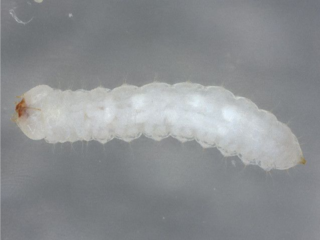
The telephone-pole beetle is a beetle native to the eastern United States, and the only living representative of the otherwise extinct family Micromalthidae. Larvae of the beetle live in decaying wood and can be pests to wooden structures, lending them their common name, the 'telephone-pole beetle.'

Frass refers loosely to the more or less solid excreta of insects, and to certain other related matter.
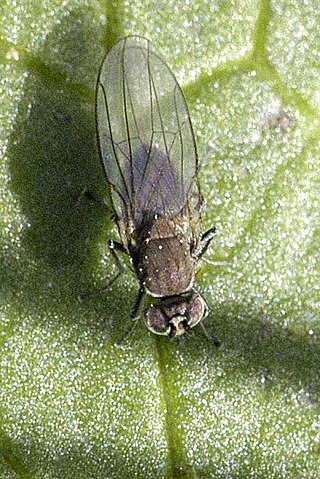
Ephydridae is a family of insects in the order Diptera.

The Agromyzidae are a family of flies, commonly referred to as the leaf-miner flies for the feeding habits of their larvae, most of which are leaf miners on various plants. It includes roughly 2,500 species, they are small, some with wing length of 1 mm. The maximum size is 6.5 mm. Most species are in the range of 2 to 3 mm.

Gracillariidae is an important family of insects in the order Lepidoptera and the principal family of leaf miners that includes several economic, horticultural or recently invasive pest species such as the horse-chestnut leaf miner, Cameraria ohridella.

The Sciaridae are a family of flies, commonly known as dark-winged fungus gnats. Commonly found in moist environments, they are known to be a pest of mushroom farms and are commonly found in household plant pots. This is one of the least studied of the large Diptera families, probably due to the small size of these insects and the similarity among species.

Nepticulidae is a family of very small moths with a worldwide distribution. They are characterised by eyecaps over the eyes. These pigmy moths or midget moths, as they are commonly known, include the smallest of all living moths, with a wingspan that can be as little as 3 mm in the case of the European pigmy sorrel moth, but more usually 3.5–10 mm. The wings of adult moths are narrow and lanceolate, sometimes with metallic markings, and with the venation very simplified compared to most other moths.

Stenoptilia zophodactylus, also known as the dowdy plume, is a species of moth of the family Pterophoridae found worldwide. It was first described by Philogène Auguste Joseph Duponchel in 1840.
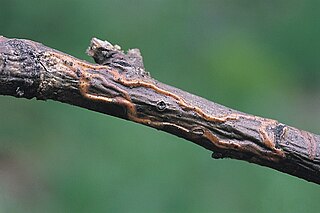
Ectoedemia atrifrontella is a moth of the family Nepticulidae. It is found in most of Europe except Iceland, Ireland, Belgium and most of the Balkan Peninsula. It is also present in the Near East.

Ectoedemia liebwerdella is a moth of the family Nepticulidae. It occurs locally in central and southern Europe, east to the Volga and Ural regions of Russia.
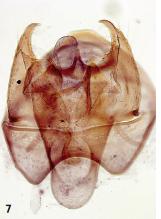
Ectoedemia amani is a moth of the family Nepticulidae. It is found in southern Norway, southern Sweden, Denmark, Austria, and Macedonia.

Trifurcula subnitidella is a moth of the family Nepticulidae. It is widespread in Europe southward to the northern border of the Sahara in Tunisia and eastward to the Crimea and Asia minor.
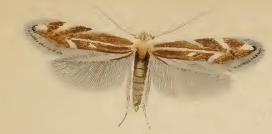
Bucculatrix maritima is a species of moth of the family Bucculatricidae. It is found in most of Europe, Russia and Japan. It was first described in 1851 by Henry Tibbats Stainton.

Phyllonorycter froelichiella is a moth of the family Gracillariidae. It is found in all of Europe, except Greece.

Dichelia histrionana is a species of moth of the family Tortricidae. It is found from Fennoscandia to Belgium, Italy and Greece and from the Netherlands to Poland and Romania.
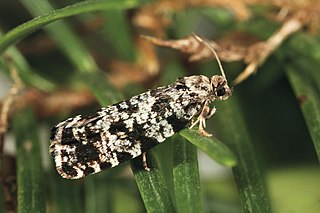
Pseudohermenias abietana is a species of moth of the family Tortricidae. It is found from Fennoscandia and northern Russia to the Pyrenees, Sardinia and Italy and from France to Romania.

Bucculatrix demaryella is a moth of the family Bucculatricidae. The species was first described by Philogène Auguste Joseph Duponchel in 1840. It is found in most of Europe, Russia and Japan.

Exoteleia dodecella, the pine bud moth, is a moth of the family Gelechiidae. It is widely distributed from western Europe to Siberia. It is an introduced species in North America.

Profenusa thomsoni, the amber-marked birch leaf miner, is a species of sawfly in the family Tenthredinidae. It is native to the Palearctic realm but has spread to North America. The larvae feed on the foliage of birch trees.


















